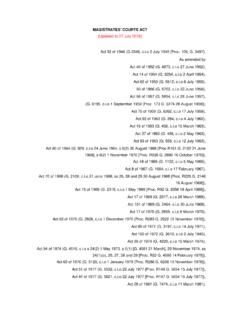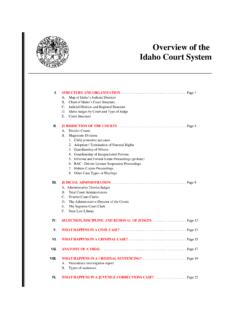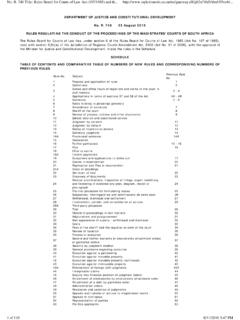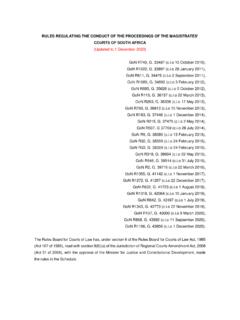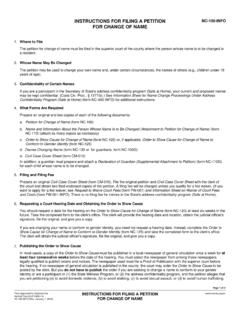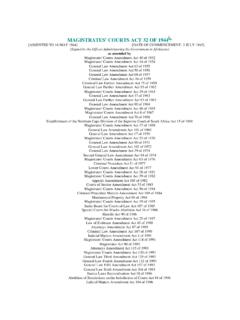Transcription of Civil Litigation - paralegal.za.org
1 Civil Litigation Edition 4 _____ Civil Litigation / SASPS Civil Litigation Introduction 1 Nature and scope of Civil procedure 1 Sources 1 Rules of court 1 Causes of action 2 Jurisdiction 2 The magistrates court 3 Matters beyond jurisdiction: section 46 3 Jurisdiction in respect of causes of action: section 29 3 Abandonment of a portion of a claim: section 38 4 Deduction of an admitted debt 5 Consent to jurisdiction 5 Jurisdiction is respect of persons 5 Parties to Litigation 6 Capacity to litigate 6 Legal representation 7 Adequate notice 7 Civil proceedings on the magistrates courts 8 Pre-trial procedure 8 Letter of demand 8 The summons 9 Service of legal process 11 Edictal citation and substituted service 12 Judgement by consent 12 Security for costs 12 Notice of intention to defend 13 Judgement by default 13 Summary judgement 14 Declaration 16 Plea 16 Exceptions and application to strike out 17 Special plea 17
2 Counter claim (Claims in Reconvention) 17 Reply to plea and plea to claim in reconvention 17 Close of pleadings 17 Other points to note 18 Preparation for trial 18 Discovery 18 Medical examinations and documents 19 Condition of an object 19 Expert notices 20 Photos, plans, models and sketches 20 Witnesses 20 Request for further particulars 20 File preparation 20 Consultations with witnesses (including expert witnesses) 21 Pre-trial conference 21 The trial 21 The judgement of the court 21 Costs 22 Application for rescission of judgement 22 Execution of judgement 23 In terpleader proceedings 25 Applications 25 Specific applications 26 Appeals 27 Civil proceedings in the High court 28 Civil jurisdiction 28 Territorial limits 28 Officials of the court 28 Judges 28 _____ Civil Litigation / SASPS The registrar 28 The sheriff 29 The taxing master 29 The family advocate 29 Interpreters 29 The court orderly 29 Judge s clerks 29 The court stenographer 29 The Master of the High court 29 Attorneys and
3 Advocates 30 The form of Civil proceedings 30 PRINTING HISTORY 1st Edition June 2006 2nd Edition November 2006 3rd Edition January 2008 Revised Edition August 2009 4th Edition January 2011 Revised Edition January 2012 THE SOUTH AFRICAN SCHOOL OF PARALEGAL STUDIES CC Reg No 1994/020523/23 7 Greenwich Grove, Station Road, Rondebosch, 7700 (SASPS) _____ This document contains proprietary information that is protected by copyright. All rights are reserved. No part of this document may be photocopied, reproduced, electronically stored or transmitted, or translated without the written permission of the SASPS. _____ Civil Litigation / SASPS / (ii) _____ Civil Litigation / SASPS / Page 1 INTRODUCTION Nature and scope of Civil procedure The law gives a citizen certain rights and remedies.
4 If one of these rights is infringed, the aggrieved citizen can enforce his rights through the court system. The rules of Civil procedure are concerned with the manner in which an aggrieved party may bring his case before the appropriate court for an authoritative decision that is enforced by the state. In a matter involving a dispute, the first issue to be determined is whether the aggrieved party has a right and if so, whether that right has been infringed. If a right has been infringed then it follows that the injured party does have a remedy because there is a general rule that where there is a right there is a remedy (ubi ius ibi remedius). The next step would be to determine which court is competent to grant the remedy. This involves the issue of jurisdiction.
5 By jurisdiction is basically meant the competency of a court to hear an issue and give an authoritative decision. The issue of jurisdiction is addressed before commencement of proceedings and the selection of a competent court in turn influences the nature and conduct of proceedings. The major courts with Civil jurisdiction in South Africa are the following: the Supreme court of Appeal; the High Courts; and the magistrates' courts, consisting of the - district magistrates courts, and - regional magistrates courts (of which there are 62 throughout South Africa). The conduct of proceedings in each court is different, although there are similarities in many respects between the High court and the magistrate's court procedure. As of the 15th of October 2010 the Magistrates court procedures were amended to bring the procedures in line with the High court procedures.
6 Sources Most of our law of procedure has been introduced by legislation and is based on the English system of procedure, although some High court Rules are based on common law, for example, the rules relating to provisional sentence. In the main, the rules regulating High court procedure are to be found in the Supreme court Act 59 of 1959 and the Rules of court . The source of procedural rules relating to the magistrates' courts, on the other hand, is the statute responsible for their establishment, namely the Magistrates' Courts Act 32 of 1944 and the Rules promulgated in terms thereof. Rules of court The purpose of the rules of court is to allow litigants to address the issues in dispute between them as expeditiously and inexpensively as possible and at the same time ensure that the courts dispense justice uniformly and fairly.
7 The rules applicable to magistrate's courts were originally devised by the Rules Board established under the Magistrates' Courts Act, but are now also regulated by the Rules Board for Courts of Law. _____ Civil Litigation / SASPS / Page 2 Due to the amendment of the rules of court on the 15th of October 2010, those matters in which action was commenced prior to 15 October 2010 are still governed by the rules of the Magistrates court that were applicable prior to 15 October 2010. Causes of action A party must have a legally recognised right which has been infringed before legal proceedings can be embarked on in order to enforce that right. In Litigation this is commonly known as a 'cause of action'. In other words, a party must have a legally recognised cause or reason for the action he wishes to take.
8 The following are causes of action which frequently arise in practice: goods sold and delivered; work done and materials supplied; professional services rendered; professional services rendered and disbursements made; money lent and advanced; dishonoured cheques; acknowledgements of debt; motor collisions; overpayment; and instalment sale agreement. EXAMPLE Mr and Mrs X contract with Pleasure Pools for the construction of a swimming pool. Pleasure Pools complete the job and submit their account to Mr and Mrs X for payment. Mr and Mrs X fail to settle the account and despite various demands persist in their non-payment. Pleasure Pools decide to institute legal action. Their cause of action will be work done and materials supplied. Jurisdiction Once it has been ascertained that a party has a cause of action, it must be established in which court to institute the claim.
9 Various factors play a role in a client's decision whether to sue in the magistrate's court (district or regional ) or the High court . The following factors are important considerations in deciding in which court to institute action: whether the magistrate's court (district or regional ) has jurisdiction to hear the matter; costs; speed and urgency; convenience; complexity of the matter; importance of the case to the client; and quality of the justice dispensed. _____ Civil Litigation / SASPS / Page 3 The magistrate's court Sections 46 and 29 of the Magistrates' Courts Act 32 of 1944 set the boundaries of jurisdiction of the district and regional magistrate's courts with regard to causes of action in respect of their value and their nature (see Annexure A).
10 Matters beyond jurisdiction: section 46 In terms of section 46, certain matters are beyond the jurisdiction of the magistrates' courts, regardless of the amount or value of the claim. Magistrates' courts do not have jurisdiction to hear the following types of cases (please study section 46 in Annexure A for a full description): matters in which the validity or interpretation of a will or other testamentary document are in question; matters in which the status of a person with respect to mental capacity are sought to be affected; matters in which the plaintiff seeks specific performance without an alternative of payment of damages, except in: the rendering of an account in respect of which the claim does not at present exceed *; the delivery or transfer of property, movable or immovable, at present not exceeding *; the delivery or transfer of property, movable or immovable, where the consent of the parties has been obtained in terms of section 45.
